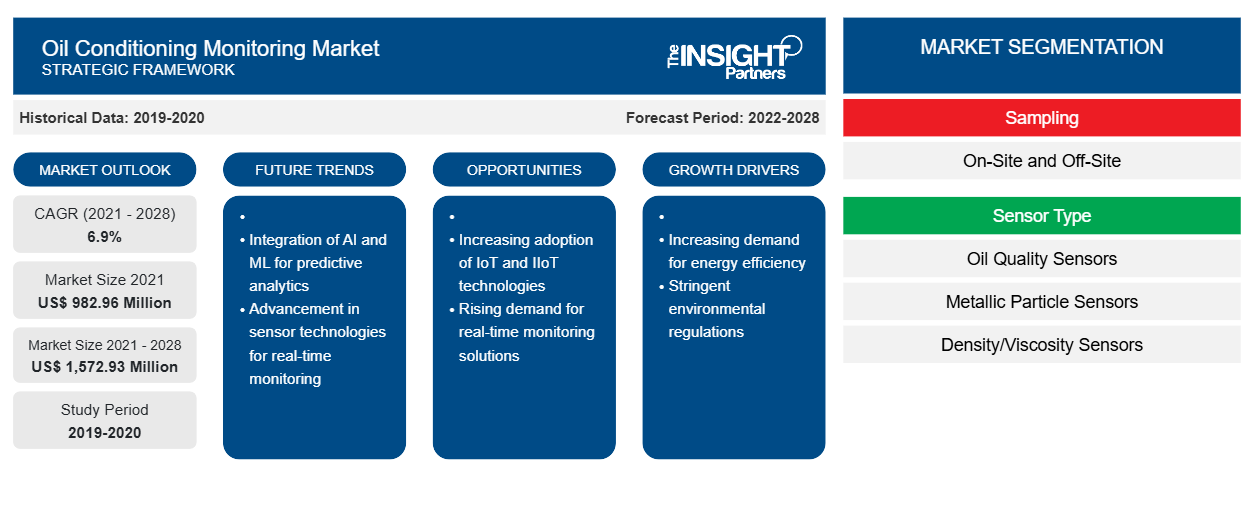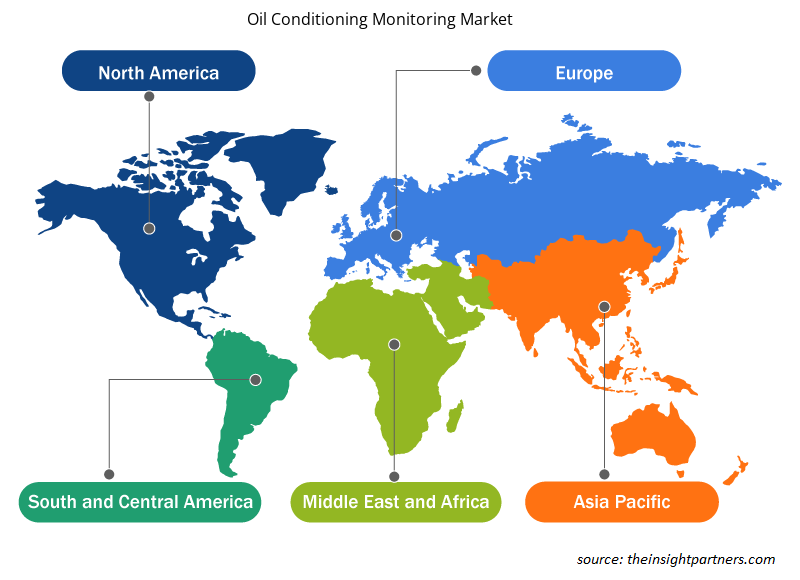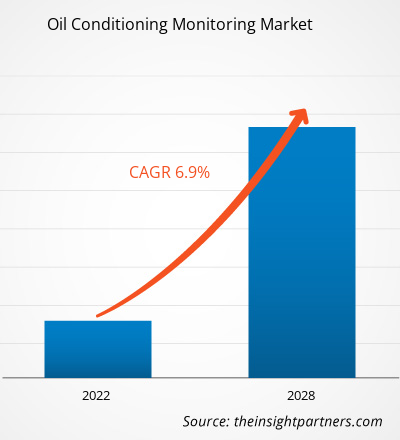The oil conditioning monitoring market is expected to grow from US$ 982.96 million in 2021 to US$ 1,572.93 million by 2028; it is estimated to grow at a CAGR of 6.9% during 2021–2028.
The use of the industrial internet of things is reducing the oil and gas industries environmental impact substantially, from increased efficiency to reduced safety risk and reduced travel. Oil and gas firms are paying attention to the IIoT because it can help them save energy, avoid oil spills and other catastrophes, and emit less carbon. The IIoT may also monitor energy and resource consumption. Intelligent technologies are influencing practically every area of the oil and gas supply chain, from operations to consumer interaction. Smart devices in the supply chain are giving the oil and gas industry a chance to compete in a commoditized world, as well as a chance to modernize quickly in a legacy sector. In addition, the Internet of Things (IoT) has the potential to significantly improve data collection methods. The oil and gas sector values efficiency and precision almost more than any other industry.
Customize This Report To Suit Your Requirement
You will get customization on any report - free of charge - including parts of this report, or country-level analysis, Excel Data pack, as well as avail great offers and discounts for start-ups & universities
Oil Conditioning Monitoring Market: Strategic Insights

- Get Top Key Market Trends of this report.This FREE sample will include data analysis, ranging from market trends to estimates and forecasts.
Customize This Report To Suit Your Requirement
You will get customization on any report - free of charge - including parts of this report, or country-level analysis, Excel Data pack, as well as avail great offers and discounts for start-ups & universities
Oil Conditioning Monitoring Market: Strategic Insights

- Get Top Key Market Trends of this report.This FREE sample will include data analysis, ranging from market trends to estimates and forecasts.
Impact of COVID-19 Pandemic on Oil Conditioning Monitoring Market
The COVID-19 pandemic has shaken several industries across the world. The lockdown hindered the operations of various industries, including manufacturing and IT. However, essential industries such as fast-moving consumer goods (FMCG) and pharmaceutical had to continue their operations. The oil sector is during its third price crash in the last twelve months. The industry recovered after the first two shocks, and business as usual resumed. This time, though, things are different. The current situation includes a supply shock, a historically low demand, and a worldwide humanitarian catastrophe. Furthermore, the financial and structural health of the sector is worse than in past crises. Poor returns have been attributed to the introduction of shale, excess production, and liberal finance markets that disregarded the lack of capital discipline. With prices nearing 30-year lows and public pressure increasing, leaders recognized that change is unavoidable. The COVID-19 problem is intensifying. Therefore, the COVID-19 epidemic and its repercussions are wreaking havoc on oil conditioning monitoring market
Oil Conditioning Monitoring Market Insights
Rising Demand for Power Generation across the Globe Fuels Growth of Oil Conditioning Monitoring Market
Energy consumption across the world is anticipated to increase in coming years, with yearly usage reaching ~778 Etta Joule by 2035 due to the projected increase in global population and economic and industrial growth in developing nations, such as China and India. Industry machinery and other equipment designers and manufacturers are constantly looking for ways to improve the energy efficiency of their products by reducing heating and cooling losses, improving heat transfer, and improving electric motors. Nuclear power remains necessary owing to factors such as necessity for reliable and baseload electricity, and the threat of global climate change. Furthermore, nuclear power is a critical component of energy strategy since it is the only large-scale source of almost carbon-free electricity. It produces about 20% of the global power and more than 60% of the low-carbon energy. Nuclear power plants have emerged as a source of energy to meet the increased demand for electricity. The plants face the issue of the nuclear fuel cycle, and eventually, the decommissioning of such facilities as part of their life cycle or in the event of a natural or man-made disaster, which is propelling the demand for oil conditioning monitoring in the facilities.
Sampling - Based Market Insights
Based on sampling, the global oil conditioning monitoring market is segmented into on-site and off-site. In 2020, the off-site segment led the oil conditioning monitoring segment accounted for a larger share in the market.
Sensors Type-Based Market Insights
Based on sensor type, the oil conditioning monitoring market is segmented into oil quality sensors, metallic particle sensors, and density/viscosity sensors. In 2020, the oil quality sensor segment led the oil conditioning monitoring segment accounted for the largest share in the market.
Product-Based Market Insights
Based on product, the oil conditioning monitoring market is segmented into turbines, compressors, engines, gear systems, and hydraulic systems. In 2020, the turbines segment led the oil conditioning monitoring segment accounted for the largest share in the market.
Measurement-Based Market Insights
Based on measurement, the oil conditioning monitoring market is segmented into temperature, pressure, density, viscosity, dielectric, TAN/TBN, water dilution, fuel dilution, soot, and wear particles. In 2020, the viscosity segment led the oil conditioning monitoring segment accounted for the largest share in the market.
Industry-Based Market Insights
Based on industry, the oil conditioning monitoring market is segmented transportation, industrial, oil and gas, energy and power, and mining. In 2020, the transportation segment led the oil conditioning monitoring segment accounted for the largest share in the market.
The players operating in the oil conditioning monitoring market adopt strategies such as mergers, acquisitions, and market initiatives to maintain their positions in the market. A few developments by key players are listed below:
- In August 2020, ALS had begun a strategic collaboration with Poseidon Systems, a Rochester-based developer of advanced online oil condition monitoring (OCM) solutions. The firms have a common goal of transforming OCM by combining Poseidon Systems' award-winning online OCM technology with ALS' experience in oil analysis and testing.
- In August 2020, Des-Case Corporation, a global manufacturer of specialty filtration products that improve process equipment reliability and extend lubricant life, has announced the launch of a new remote diagnostic monitoring subscription plan for industrial lubricated assets, giving customers peace of mind that the lubricant health, cleanliness, and humidity inside their critical assets are monitored in real time.
Oil Conditioning Monitoring Market Regional Insights
The regional trends and factors influencing the Oil Conditioning Monitoring Market throughout the forecast period have been thoroughly explained by the analysts at Insight Partners. This section also discusses Oil Conditioning Monitoring Market segments and geography across North America, Europe, Asia Pacific, Middle East and Africa, and South and Central America.

- Get the Regional Specific Data for Oil Conditioning Monitoring Market
Oil Conditioning Monitoring Market Report Scope
| Report Attribute | Details |
|---|---|
| Market size in 2021 | US$ 982.96 Million |
| Market Size by 2028 | US$ 1,572.93 Million |
| Global CAGR (2021 - 2028) | 6.9% |
| Historical Data | 2019-2020 |
| Forecast period | 2022-2028 |
| Segments Covered |
By Sampling
|
| Regions and Countries Covered | North America
|
| Market leaders and key company profiles |
Oil Conditioning Monitoring Market Players Density: Understanding Its Impact on Business Dynamics
The Oil Conditioning Monitoring Market market is growing rapidly, driven by increasing end-user demand due to factors such as evolving consumer preferences, technological advancements, and greater awareness of the product's benefits. As demand rises, businesses are expanding their offerings, innovating to meet consumer needs, and capitalizing on emerging trends, which further fuels market growth.
Market players density refers to the distribution of firms or companies operating within a particular market or industry. It indicates how many competitors (market players) are present in a given market space relative to its size or total market value.
Major Companies operating in the Oil Conditioning Monitoring Market are:
- CM Technologies GmbH,
- Des-Case,
- Hydac Technology Limited
- Intertek Group Plc.
- Poseidon Systems
Disclaimer: The companies listed above are not ranked in any particular order.

- Get the Oil Conditioning Monitoring Market top key players overview
The global oil conditioning monitoring market has been segmented as mentioned below:
By Sampling- On-site
- Off-site
By Sensors Type- Oil Quality Sensors
- Metallic Particle Sensors
- Density/Viscosity Sensors
By Product- Turbines
- Compressors
- Engines
- Gear Systems
- Hydraulic Systems
By Measurement- Temperature
- Pressure
- Density
- Viscosity
- Dielectric
- TAN/TBN
- Water Dilution
- Fuel Dilution
- Soot
- Wear Particles
By Industry- Transportation
- Industrial
- Oil & Gas
- Energy & Power
- Mining
By Geography- North America
- US
- Canada
- Mexico
- Europe
- France
- Germany
- Italy
- UK
- Russia
- Rest of Europe
- Asia Pacific (APAC)
- China
- India
- South Korea
- Japan
- Australia
- Rest of APAC
- Middle East & Africa (MEA)
- South Africa
- Saudi Arabia
- UAE
- Rest of MEA
- South America (SAM)
- Brazil
- Argentina
- Rest of SAM
- US
- Canada
- Mexico
- France
- Germany
- Italy
- UK
- Russia
- Rest of Europe
- China
- India
- South Korea
- Japan
- Australia
- Rest of APAC
- South Africa
- Saudi Arabia
- UAE
- Rest of MEA
- Brazil
- Argentina
- Rest of SAM
Company Profiles - CM Technologies GmbH
- Des-Case
- Hydac Technology Limited
- Intertek Group Plc.
- Poseidon Systems
- Rheonics Group
- SGS SA
- Special Oilfield Services Co. LLC
- TAN Delta Systems Limited
- Veritas Petroleum Services
Frequently Asked Questions
Which are the major companies in the oil condition monitoring market?
The major companies in oil condition monitoring market includes Intertek Group Plc.; SGS SA; Hydac Technology Limited; Veritas Petroleum Services; and Des-Case.
Which are the major industries for oil condition monitoring market?
The major industries in oil condition monitoring includes transportation, power generation, industrial, mining, and oil &gas. Oil and gas is contributing a substantial revenue to the market growth.
Which region has dominated the oil conditioning monitoring market?
In 2020, North America led the market with a substantial revenue share, followed by APAC and Europe. North America is a prospective market for oil monitoring equipment manufacturers.
What are key factors driving the oil conditioning monitoring market growth?
The study of lubricating oils in use helps in lowering operating costs, reducing downtimes, increasing plant and equipment lives, and making effective maintenance plans. Lubricating oil analysis is also being used to check the condition of engines and other machinery. It is used to lubricate most lubricated mechanical systems, such as engines, gear gearboxes, hydraulics, and the like, and has a wide range of applications in industries such as construction, power production, and transportation, including aircraft, fleet operations, and public transit. In addition, under fault circumstances, many additional changes may occur in oils, such as dilution by fuels or contamination by water or anti-freeze. As a result, efficient oil monitoring aids in the provision of cost-effective services in a variety of industrial surroundings.
Which product is expected to dominate the market in the forecast period?
The global oil conditioning monitoring market was dominated by the oil quality sensors during the forecast period, which accounted for 61.0% in 2020. Oil Quality Sensors conditioning monitoring are traditional equipment that are used majorly for oil quality detection.
What are market opportunities for oil conditioning monitoring market?
The market opportunity lies in developing countries. Developing countries have become a hub of opportunity for various markets, including oil conditioning monitoring market. In order to improve the overall infrastructure, government authorities in these countries are planning and investing huge amount in machines and technologies.
- Historical Analysis (2 Years), Base Year, Forecast (7 Years) with CAGR
- PEST and SWOT Analysis
- Market Size Value / Volume - Global, Regional, Country
- Industry and Competitive Landscape
- Excel Dataset
Testimonials
I wish to appreciate your support and the professionalism you displayed in the course of attending to my request for information regarding to infectious disease IVD market in Nigeria. I appreciate your patience, your guidance, and the fact that you were willing to offer a discount, which eventually made it possible for us to close a deal. I look forward to engaging The Insight Partners in the future, all thanks to the impression you have created in me as a result of this first encounter.
DR CHIJIOKE ONYIA, MANAGING DIRECTOR, PineCrest Healthcare Ltd.The Insight Partners delivered insightful, well-structured market research with strong domain expertise. Their team was professional and responsive throughout. The user-friendly website made accessing industry reports seamless. We highly recommend them for reliable, high-quality research services
Yukihiko Adachi CEO, Deep Blue, LLC.Reason to Buy
- Informed Decision-Making
- Understanding Market Dynamics
- Competitive Analysis
- Customer Insights
- Market Forecasts
- Risk Mitigation
- Strategic Planning
- Investment Justification
- Identifying Emerging Markets
- Enhancing Marketing Strategies
- Boosting Operational Efficiency
- Tracking Industry Innovations
- Aligning with Regulatory Trends
Yes! We provide a free sample of the report, which includes Report Scope (Table of Contents), report structure, and selected insights to help you assess the value of the full report. Please click on the "Download Sample" button or contact us to receive your copy.
Absolutely — analyst assistance is part of the package. You can connect with our analyst post-purchase to clarify report insights, methodology or discuss how the findings apply to your business needs.
Once your order is successfully placed, you will receive a confirmation email along with your invoice.
• For published reports: You’ll receive access to the report within 4–6 working hours via a secured email sent to your email.
• For upcoming reports: Your order will be recorded as a pre-booking. Our team will share the estimated release date and keep you informed of any updates. As soon as the report is published, it will be delivered to your registered email.
We offer customization options to align the report with your specific objectives. Whether you need deeper insights into a particular region, industry segment, competitor analysis, or data cut, our research team can tailor the report accordingly. Please share your requirements with us, and we’ll be happy to provide a customized proposal or scope.
The report is available in either PDF format or as an Excel dataset, depending on the license you choose.
The PDF version provides the full analysis and visuals in a ready-to-read format. The Excel dataset includes all underlying data tables for easy manipulation and further analysis.
Please review the license options at checkout or contact us to confirm which formats are included with your purchase.
Our payment process is fully secure and PCI-DSS compliant.
We use trusted and encrypted payment gateways to ensure that all transactions are protected with industry-standard SSL encryption. Your payment details are never stored on our servers and are handled securely by certified third-party processors.
You can make your purchase with confidence, knowing your personal and financial information is safe with us.
Yes, we do offer special pricing for bulk purchases.
If you're interested in purchasing multiple reports, we’re happy to provide a customized bundle offer or volume-based discount tailored to your needs. Please contact our sales team with the list of reports you’re considering, and we’ll share a personalized quote.
Yes, absolutely.
Our team is available to help you make an informed decision. Whether you have questions about the report’s scope, methodology, customization options, or which license suits you best, we’re here to assist. Please reach out to us at sales@theinsightpartners.com, and one of our representatives will get in touch promptly.
Yes, a billing invoice will be automatically generated and sent to your registered email upon successful completion of your purchase.
If you need the invoice in a specific format or require additional details (such as company name, GST, or VAT information), feel free to contact us, and we’ll be happy to assist.
Yes, certainly.
If you encounter any difficulties accessing or receiving your report, our support team is ready to assist you. Simply reach out to us via email or live chat with your order information, and we’ll ensure the issue is resolved quickly so you can access your report without interruption.















The List of Companies - Oil Conditioning Monitoring Market
- CM Technologies GmbH,
- Des-Case,
- Hydac Technology Limited
- Intertek Group Plc.
- Poseidon Systems
- Rheonics Group
- SGS SA
- Special Oilfield Services Co. LLC
- TAN Delta Systems Limited
- Veritas Petroleum Services






 Get Free Sample For
Get Free Sample For